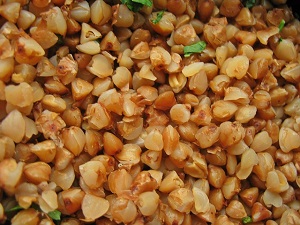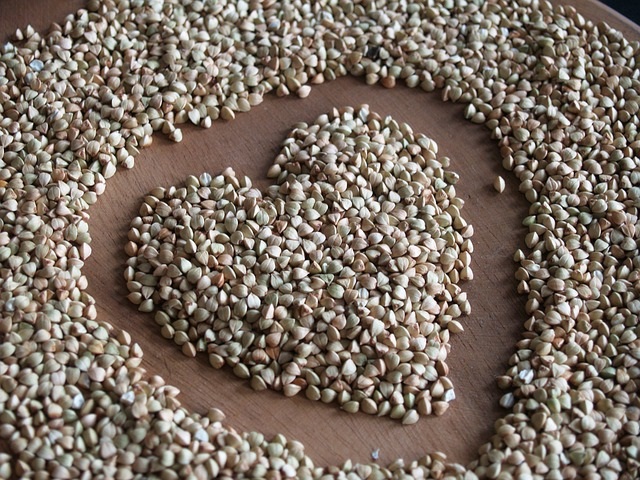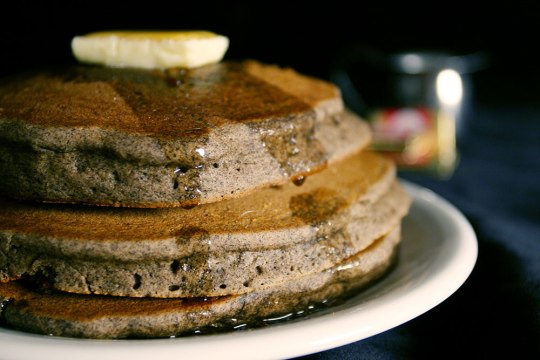You might have noticed that buckwheat hotcakes are prominently displayed on our menu, as they are a European staple that doesn’t quite have the same traction here in the US. You might then wonder just what in the world is buckwheat, and why on earth would it be used to make pancakes?
Because it’s delicious and nutritious, buckwheat and buckwheat cakes are actually a staple in global cuisine, not just as European breakfast fare…though buckwheat hotcakes are a fantastic way to start the day. Buckwheat is rich in carbs, fiber and small amounts of high-quality protein, so it is a perfect ingredient to include in your foods and delectable recipes. That’s why at Old European, we include this nutrient-rich ingredient in our recipes to bring you some succulent and mouth-watering dishes. We combine the health benefits of buckwheat and create tasty food recipes that will leave you craving for more!
No wonder we can create some delicious recipes from buckwheat, but you should know what it actually is and the health benefits it offers.
Just what is buckwheat?
Buckwheat Is Definitely Not A Grain

As we know, wheat is a cereal crop, a grain, much like other crops such as barley, rice and so on. Wheat is a popular crop that is used to produce a wide range of products. Wheat grains are pulverized to create fine flour, which is then used to make everyday grocery products. Mostly, everything we have on our dinner table as food has wheat as a major ingredient. Breads to buns, wheat is the common ingredient used in various foods. Biscuits, pastas, noodles and even go-to snack foods have wheat in them. And, you can create tasty food recipes from these products…but buckwheat flour or buckwheat groats have their own benefits.
Buckwheat is different from wheat. It isn’t a grain, and it isn’t a cereal. In fact, it isn’t even related. The agri food chem of buckwheat differs highly from the wheat and other crops. It is not like a common crop or grain but is a plant that has flowers and seeds. So it neither falls in the grains category nor the crop category. So what is it really?
Cereal crops, you see, are all forms of grasses. Those grasses have seeds at the top of the stalk that is harvested, dried and then used to create the particular product that is desired. Rice stays as rice, of course, but wheat is often milled into flour, barley is malted and used for beer or whiskey production – or dried for use as food – but buckwheat is not among them.
Instead, buckwheat is a member of the Polygonaceae family, informally known as the knotweed family. This includes plants like sorrel, knotweeds and also rhubarb. The buckwheat plant produces a delicate white flour but also hardy, triangular seeds similar to beech nuts. The seed is much like a sunflower, with a hard outer hull and a single seed. Hulled seeds of the buckwheat are called buckwheat groats. They cannot be counted as grains.
The seeds can be dried and pulverized into flour. The raw buckwheat groats can be used to create a number of gluten-free dishes. The earliest known evidence of buckwheat flour consumption dates to about 6000 BC in Southeast Asia, mainly China. Then, it was introduced in Russia, traveling across the Middle East. It quickly spread as evidence of buckwheat consumption was uncovered in northern Europe within a few hundred years of that date. It then spread all over Asia (including into Japan) and into Europe.
The health benefits buckwheat offered made it quite popular for the longest time. In fact, NOT eating buckwheat and relying instead on wheat flour is something of a modern phenomenon.
What’s So Great About Buckwheat?!
Buckwheat has certain advantages over wheat flour in several dimensions.

First, it is a hardier plant with a shorter growing season, at 10 to 12 weeks, i.e., around 3 to 4 months. The plantation may vary from region to region, but common farming practices include sowing in summer until August. As the flowering starts within the 10th to 12th week, looking at the leaves and flowers, one can determine it is ready for harvesting. Farmers find buckwheat cultivation convenient due to its short growth span.
Buckwheat also does well in nutrient-poor soil. So, if you are not so lucky enough to have nutrient-rich soil, then buckwheat farming is the ideal option. It reduces the challenges you have to deal with soil testing, measurements and waiting for the results. If you know the land is not so nutrient-rich, go for buckwheat farming. In fact – successful cultivation actually requires fertilizer to be withheld.
Additionally, Buckwheat is one of the easiest plants to grow that requires less maintenance. If you are among the ones that found less time to spend on the farms, buckwheat is a perfect option. While these are some of the agricultural benefits of buckwheat, the plant also offers a myriad of health benefits.
Nutritionally, buckwheat is only marginally higher in total proteins than wheat flour, but most wheat protein is gluten and is therefore not very bioavailable. Buckwheat protein, however, is almost 90 percent bioavailable, so it is readily absorbed by the body. Along with the complex carbohydrates that make buckwheat flour a bit more complete nutritionally.
Buckwheat has a moderate amount of fiber present, which is good for digestion. The fiber gives you a feeling of fullness and prevents overeating, thus helping in weight management. So if you wish to have a fiber-rich meal, then buckwheat products are the best in your diet. It also improves colon health.
Buckwheat is also found to be rich in carbs, which are the necessary requirements of a meal. Complex carbohydrates take longer to break down, which helps keep blood sugar levels stable for longer. So, if you are advised to eat foods that help keep sugar levels in control, then add buckwheat to your diet.
Food recipes from Buckwheat flour and buckwheat groats are also found to be a rich source of iron. Iron is a prime nutrient in the blood that carries oxygen and other nutrients to all parts of the body. So, an iron-rich diet can help prevent Anemia and maintain optimal RBCs to keep the body active and fit.
Buckwheat also has adequate amounts of vitamins and minerals. Manganese, copper, phosphorus is commonly found in buckwheat groats. So, from keeping a healthy metabolism and preventing heart disease to optimal growth and maintenance of the body, buckwheat is the perfect ingredient in your dishes.
Buckwheat also serves as a powerful antioxidant, removing harmful substances from the body. It prevents inflammation and also enhances the immune system. So, buckwheat bread in the dinner can eliminate ‘free radicals’ from our body.
Additionally, buckwheat is gluten-free, so the flour and any products – such as bread, buckwheat pasta (wildly popular in Japan, Italy and elsewhere) and buckwheat hotcakes – can be readily served and eaten by those suffering from celiac disease or who might otherwise be gluten intolerant.
Gluten-free products are also found helpful in treating digestive problems. People who usually suffer from bloating, constipation, fatigue or inflammation can try out gluten-free buckwheat products and keep their digestive system healthy.
Gluten-free buckwheat dishes also boost energy. People having celiac disease often feel tired and dull. A healthy, organic, gluten-free diet can give the required energy to keep up with daily lifestyle and have a better exercise routine.
If it grows easier and is a bit better for you than wheat, why is it that buckwheat isn’t more popular?
Well, the thing is that other cereals were considered more delectable (wheat flour does make some amazing bread and cakes) and eventually, the agricultural revolution along with the invention of nitrogen-based fertilizer made growing wheat, corn, and barley far more tenable. Demand just started to drop away in the early 20th century as the other crops (which were also more profitable, it must be said) became more prevalent. So, the buckwheat didn’t get the desired attention as it should, and the world moved on to meals made from wheat and other cereal crops. But as the world loves to experiment and chefs are on their way to find innovative dishes for food connoisseurs, buckwheat found its way. The healthy and nutritious grain is now used to produce a number of flavorful dishes, and pancakes or hotcakes are among them.
What Are Buckwheat Hotcakes Like?
That all aside…what are buckwheat hotcakes like? Are they still delicious?
Absolutely!

The first thing you will find different in buckwheat hotcakes is their appearance. As the buckwheat has a shade of gray, the pancakes are usually darker in color if no other artificial color is added.
As to the taste, you’ll notice they are a little denser, a little chewier than flour pancakes, though not by much at all. You’ll also notice a bit more savory flavor. You’ll also notice that they are hearty and delicious, especially with your favorite toppings!
Buckwheat pancakes have a little earthy texture and somewhat little bitterness. But, one can experiment with toppings and other ingredients to get the desired taste. There is also a nuttier taste in the cake.
In fact, buckwheat pancakes are eaten in dozens of countries around the world on a regular basis. They are part of the menu during certain religious festivals in India, and they are very popular in Japan. That country hasn’t relinquished buckwheat in lieu of wheat flour entirely, as buckwheat noodles – buckwheat soba noodles are quite popular for instance – are a common food item.
Popular Buckwheat Food and Recipes?
Well, there are several food recipes you can try with buckwheat flour and buckwheat groats.
Buckwheat groats can be roasted or toasted to get the intense flavor and enjoy as evening snacks. Try out different methods of toasting to get crispness and crunchiness.
Buckwheat Salads: Soak the buckwheat groats in water at night and drain the excess water from the groats. Now add these groats in salads, mix them well and enjoy a fresh salad. Give your body the rich nutrients it has.
Japanese Soba Noodles: Favorite of both kids and adults, noodles are the best option to relieve unexpected hunger. Easy to make, boil the noodles in hot water and throw in some veggies. And, if you want to add some flavor, add a few spills of sauces and creams.
Tabbouleh: A healthy salad from the Middle East, the buckwheat tabbouleh is an awesome mixture of buckwheat porridge, veggies, olive oil and lemon juice. Try out this healthy and fresh buckwheat dish and enjoy the traditional middle east food.
Buckwheat pancakes and crepes are also quite popular in most of Europe, which is why they are a staple menu item here at the Old European in Post Falls. We strive to give you an authentic European dining experience, which is why menu items like buckwheat hotcakes, abelskivvers, and so much more are staple menu items!
What is the difference between wheat and buckwheat?
Wheat is a cereal crop that is used to create a variety of foods and products. Unlike its name, buckwheat is actually a plant that has flowers and seeds. It is not grown in the chilling weather like wheat but is harvested in that season. The frosty weather could damage the flowers and seeds of buckwheat.
What is buckwheat made from?
The buckwheat comes from the Fagopyrum esculentum plant. It is not a cereal crop or a grain. The edible forms of buckwheat are buckwheat flour and buckwheat seeds. The buckwheat seeds are dried and then pulverized to create a fine powder, which can later be used to produce pancakes, loaves of bread and more.
Is buckwheat a grain or a seed?
Buckwheat is neither a crop nor a grain. They are actually seeds harvested from a flowering plant related to rhubarb. The buckwheat seeds are usually triangularly shaped and resemble the beech nut. Most of the time, buckwheat flour is referred to come from a grain due to its name, but that’s not the case. They are buckwheat seeds.
What does buckwheat taste like?
It varies from recipe to recipe, but the original taste of buckwheat is somewhat nuttier and slightly bitter. Professional chefs use honey or artificial flavors to add extra flavor to the dishes. The buckwheat also has an earthy texture. The taste could also vary as per the groat or the flour dishes. At the Old European, you can find a variety of dishes.


